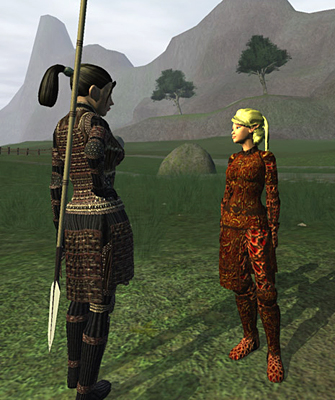Jun 3, 2008 4
Machinima: D.I.Y.C.G.I.
Unless you’re a huge nerd, you’ve probably never heard of machinima (of course, if you’re reading these words, you’re probably a pretty big nerd). But in case a non-nerd has accidentally stumbled on this blog, let me briefly define machinima as home movies made by manipulating characters in a video game (usually a role-playing game), then recording, editing, and dubbing said manipulations to tell stories. Here are a few examples.
 It’s no secret that the tools of media production and distribution have been democratised: tools like computers and software capable of editing video and audio, or even producing original music are no longer accessible only to the captains of industry. And YouTube and Google Video let anyone distribute their videos easily. Note that these are all consumer applications released with a high-end amateur market in mind. The intention was to allow anyone with a few thousand dollars to be able to produce and distribute videos of reasonably good quality.
It’s no secret that the tools of media production and distribution have been democratised: tools like computers and software capable of editing video and audio, or even producing original music are no longer accessible only to the captains of industry. And YouTube and Google Video let anyone distribute their videos easily. Note that these are all consumer applications released with a high-end amateur market in mind. The intention was to allow anyone with a few thousand dollars to be able to produce and distribute videos of reasonably good quality.
But while all this gear is very helpful, none of it addresses the problem of what actually goes in front of the camera. The costs of post-production have been scaled down, but the costs of production (both in time and money) remain high. Even home movies shot on a handycam require a lot of effort: casting, location scouting, set dressing, wardrobe, makeup, lighting, blocking, to say nothing of the actual hours on set. A 15-minute video can require hundreds of hours of preparation and thousands of dollars — something most dilettantes aren’t able or willing to invest. The examples I posted above, on the other hand, could all be made with basically zero financial investment, once the basic startup costs (a home computer or gaming system) have been paid.
There are a couple of possible reactions to watching the different examples of machinima I link to above. You might look at them and balk at how crappy they look – the camerawork is all over the place, the body movements are jarring, and characters’ mouths don’t even move! Not quite Finding Nemo calibre. On the other hand, you might — like me — be blown away at the versatility of both setting and characterisation; the boundaries of what it’s possible to do in a video game are very strict, and yet the creators of these clips were able to put together scenarios as specific as a werewolf-versus-zombie-at-a-bar-mitzvah battle. Taking into account that not only are the capabilities of video games limited by the game’s functionality, but also that videos of this kind are something never anticipated by the games’ creators, there’s a shocking amount of specificity and artistic expression.
Here’s a million-dollar idea: why not release a set of customisable CGI characters and settings, combined with an interface that lets users control the lighting, shutter speed and camera position, and maybe even something approximating lip-synch? Basic props and set-dressing? Maybe even let people upload and download user-generated figures or items? If the components were actually created with home-video making in mind, most of the limitations of video-game based machinima could be overcome. Of course, they’d still be stock characters in stock settings, and most of the storytelling would continue to make the videos pretty much unwatchable. But it seems like there’s a demand. And it’ll happen, eventually, and sooner or later, you’ll be watching a homemade show that found its way to you because it was original, and good, and not because it was all that was on.
The development of machinima is remarkable, because not only did home-movie-makers possess a vision that exceeded their resources, but they also possessed the innovation to find a way to overcome those limitations. The exclusivity of production is removed; extrapolated to its logical extreme, there really are no obstacles to total creative freedom, even for basement auteurs. Just as important as the existence of the right tools is the existence of people out there who have the desire and the ability to produce content on a zero budget, and release it into the infosphere, expecting no remuneration. The separation of audience and performer is becoming more and more tenuous; a significant chunk of the audience, as it turns out, has a desire to create and to be heard, and will even appropriate and innovate new methods to do so.
